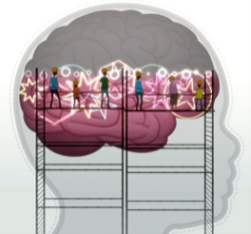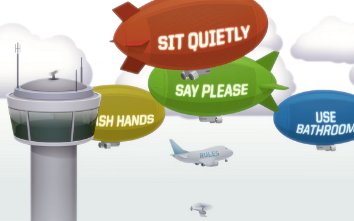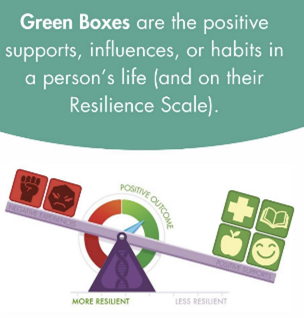|
We all have a brain story. What influences our brain story begins even before conception and can determine our long term health, our ability to deal with stressful situations, our behaviours and our potential life achievements. At Conewood Children’s Centre Nursery and Westbourne Early Years Centre our teams work hard to understand a child’s brain story. With awareness of the early life experiences of the child and their family we are better prepared to understand behaviours and provide what a child needs to 'tip their scale'.

The Alberta Family Wellness Initiative (AFWI) created a set of six tried and tested metaphors to explain how our brains are formed, the negative impact of stress and what we can do to build strong brains. Together they worked with scientists, politicians, the communities within Alberta Canada and Frameworks (an advertising and media company) to develop this shared language. Their vision was the hope that if everyone could understand early life trauma they could rebuild lives and communities to overcome adversity.
|

In the UK the NSPCC has worked with AFWI to expand upon the science and translate it into projects and campaigns with British relevance. ‘Look, say, sing, play’ is an example of one of the NSPCC initiatives. It focuses on the first metaphor of ‘Serve and Return’ – building a strong brain through infant parent/caregiver interactions. It’s simple, it’s fun and it’s exciting but it’s also science. Serve and Return builds neural pathways, back and forth just like a game of tennis. It strengthens positive brain connections and supports the building of our ‘Brain Architecture’ (the second metaphor). As AFWI teaches us, our Brain Architecture is just like building a house. When you start with a strong foundation you provide base strength for the next levels and layers of construction.
|

‘Toxic stress’ the third metaphor explains how fluctuations in hormones in the brain over sustained periods of time can influence and weaken the structure of our brains, particularly in the first 5 years of life. This happens with exposure to experiences like trauma, adversity and neglect especially if the child does not have the loving support and attachment of a caregiver to guide them through. Not all stress is bad, in fact some stress (for example starting nursery and learning to leave your parent) helps to strengthen our brains. But imagine how much harder it is for that child whose brain architecture hasn’t been built with a strong foundation or had the opportunities of positive serve and return. Consider the house without a solid base, without scaffolding or support when exposed to the elements.
|

The next metaphor in the Brain Story begins to explain this: ‘Air Traffic Control’. Just like a busy airport, a young child’s brain is constantly navigating a host of incoming and outgoing aircraft in the form of instructions, requests, emotions, boundaries, routines and expectations. Early negative experiences and toxic stress impact a child’s Air Traffic Control and their ability to plan, follow rules and contain their emotions and impulses. In short, the aeroplane crashes. This is of course what we also call executive functioning. Air traffic control systems can be developed. Sometimes all it takes is for adults to remove a few of the aeroplanes!
Building executive functioning skills is much easier and more successful in our early years.
‘Overloaded’ the fifth metaphor in the Brain Story is fairly self-explanatory. The heavier the load, the more difficult it is to cope under stress and pressure. When you are a child in an overloaded home, the challenges are even greater. This is where our support networks come in, the people who can help us to unburden the load. Even by just removing one of the overload stressors, life can feel brighter and this helps us manage the rest of our challenges.
|

The final metaphor in the brain story is the ‘Resilience Scale’ or ‘Tipping the Scale’. It determines how we respond in difficult situations.
Tipping the scale is much more difficult without strong brain architecture. It requires more positives, a greater frequency of positives and consistent positives. These can be through serve and return, through safe supportive relationships and through rewarding learning opportunities. These are all the positives we put into the green boxes to tip the scale and foster resilience.
|
Resilience is a word with loaded connotations. Often resilience is thought of as just bouncing back and getting on with it. A child should never be expected to ‘just bounce back’ after adversity.
To tip the scale for the child to have positive outcomes, they need all their trusted adults to provide good serve and return, provide positives and remove toxic stress – it’s not child’s job to ‘bounce back’ by themselves.
At Conewood Children’s Centre Nursery and Westbourne Early Years Centre, we have re-framed our approach to recognise our role in scaffolding children’s brains and creating new positive neural pathways. The metaphors together with our ‘Loving Pedagogy’ approach underpin our curriculum and the ethos that drives our practice to build strong brains. We understand a child’s brain story and reflect upon how difficult behaviours aren’t just learnt or modelled behaviour or lack of routine or inconsistent boundaries, they are actually as a result of the way a child’s brain is built.
The science behind this is real. In Early Years every day is a day to be a child’s single most important person, to serve and return, to reduce the number of aeroplanes in the busy airport, to tip the scale and most of all to help build strong brains. It's not rocket science but it is science!
For further learning AFWI provide a free 20 hour certificated training.
|